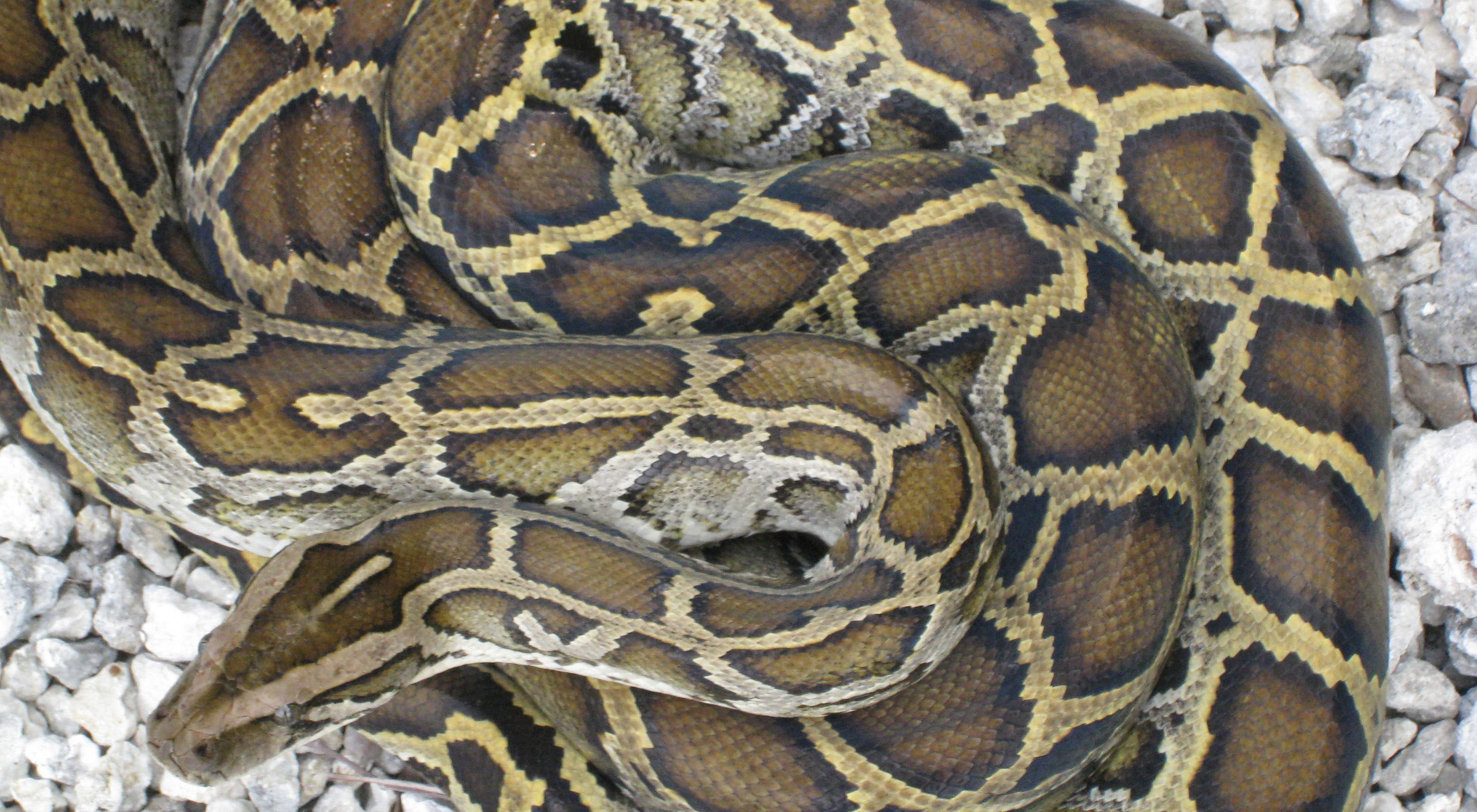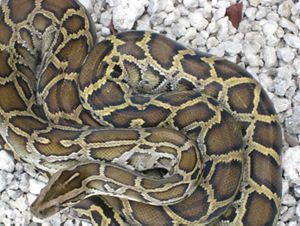The Burmese python has become an invasive species in Florida, causing a major threat to the ecosystem. It has been found to prey on native species, disrupt food chains, and even impact human safety. With the increasing population of this species, it is crucial to explore effective ways to prevent further invasions.
The Burmese python is a large constrictor snake that is native to Southeast Asia. However, due to the pet trade and unintentional releases, it has become established in the wild in Florida. Efforts to control their population have been challenging, leaving experts to search for new strategies to prevent further invasions. In this article, we will explore the various methods that can be implemented to combat this invasive species and protect the native wildlife in Florida.

Preventing Invasions from the Burmese Python
The Invasion of the Burmese Python
The Burmese Python is a large, invasive species that is native to Southeast Asia. However, in recent years, the Burmese Python has become a significant problem in Florida, where it was first introduced. The problem started when pet owners would release their snakes into the wild after they had grown too large to care for. The Burmese Python has since become a major threat to the local ecosystem, as it preys on small mammals, birds, and reptiles. In this article, we will explore ways to prevent more invasions from the Burmese Python.
Preventing the Invasion
1. Regulating Pet Ownership: One of the most effective ways to prevent the invasion of the Burmese Python is to regulate pet ownership. This means that laws should be put in place to ensure that pet owners are responsible for their pets and that they do not release them into the wild. This can be achieved through mandatory licensing, registration, and microchipping of pets.
2. Raising Awareness: Another way to prevent the invasion of the Burmese Python is to raise awareness about the issue. By educating the public about the dangers of releasing pet snakes into the wild, people will be more likely to take responsibility for their pets. This can be achieved through public service announcements, educational campaigns, and community outreach programs.
3. Early Detection and Rapid Response: Early detection and rapid response are critical in preventing the spread of invasive species. This means that monitoring programs should be established to detect the presence of the Burmese Python and other invasive species. If they are detected, rapid response measures should be taken to contain and eradicate the population.
4. Habitat Management: Habitat management is another effective way to prevent the invasion of the Burmese Python. This means that efforts should be made to restore and maintain healthy ecosystems that are resilient to invasive species. This can be achieved through the restoration of native habitats, the removal of invasive species, and the implementation of best management practices.
The Benefits of Prevention
Preventing the invasion of the Burmese Python has many benefits. It helps to protect the local ecosystem, which is home to many endangered and threatened species. It also helps to protect human health and safety, as the Burmese Python can pose a threat to people and pets. Additionally, preventing the invasion of the Burmese Python can save money on control and eradication efforts, as well as prevent the loss of revenue from tourism and recreation.
The Vs of Prevention
Preventing the invasion of the Burmese Python has many advantages over control and eradication efforts. Control and eradication efforts can be expensive and time-consuming, and they may not be effective in the long term. Prevention, on the other hand, is a proactive approach that can be more cost-effective and sustainable in the long run. Prevention also helps to minimize the impact on the local ecosystem and reduce the risk of harm to people and pets.
Conclusion
Preventing the invasion of the Burmese Python is critical in protecting the local ecosystem and human health and safety. By regulating pet ownership, raising awareness, implementing early detection and rapid response measures, and managing habitats, we can prevent the spread of this invasive species. Prevention is a proactive and cost-effective approach that has many benefits over control and eradication efforts. We must work together to prevent the invasion of the Burmese Python and protect our environment for future generations.
Frequently Asked Questions
With the Burmese Python becoming an invasive species in many parts of the world, it’s important to know what steps we can take to prevent further invasions. Here are some frequently asked questions about this issue:
What is the Burmese Python?
The Burmese Python is a large snake native to Southeast Asia. It can grow up to 23 feet in length and weigh over 200 pounds. Due to its size and beauty, it has become a popular pet and has been introduced to various parts of the world.
However, in areas where it does not have any natural predators, it has become an invasive species, causing harm to the local ecosystems and wildlife.
How did the Burmese Python become invasive?
The Burmese Python was introduced to various parts of the world as a result of the pet trade. Some of these snakes were released or escaped into the wild, where they thrived due to the absence of natural predators. They have since become established in many regions, including the Everglades in Florida.
In addition, some people have intentionally released them into the wild, either because they could no longer care for them or as a way to get rid of them.
What are the effects of the Burmese Python invasion?
The Burmese Python invasion has had a significant impact on the ecosystems and wildlife of the areas it has invaded. The snakes prey on a variety of animals, including birds, mammals, and reptiles, which can have a cascading effect on the food chain.
In addition, the presence of the snakes can lead to a decline in the population of native species and an increase in the population of prey species that the snakes feed on. This can disrupt the balance of the ecosystem and cause long-term damage.
What can we do to prevent further invasions?
One of the most important steps we can take to prevent further invasions is to regulate the pet trade. This can include stricter laws and regulations around owning and breeding exotic animals, as well as better enforcement of existing laws.
Additionally, education and outreach efforts can help raise awareness about the dangers of releasing exotic animals into the wild and the importance of responsible pet ownership.
What should we do if we spot a Burmese Python in the wild?
If you spot a Burmese Python in the wild, it’s important to report it to the appropriate authorities. In many cases, this will be a local wildlife agency or conservation group.
It’s important not to attempt to capture or handle the snake yourself, as they can be dangerous and are protected in some areas. Instead, leave it to the professionals to handle and remove the snake safely.
How Far North Will Florida’s Pythons Spread? | Invasive Biogeography
In conclusion, the Burmese python invasion is an ecological disaster that requires our immediate attention. To prevent further invasions, we need to take action by implementing effective strategies that can help control the population of these invasive species. We need to work together to educate people about the dangers of releasing exotic pets into the wild, and enforce strict regulations that discourage the importation and breeding of these animals.
Furthermore, we need to invest in research that can help us understand the behavior of these invasive species, and develop new technologies that can help us track and remove them from our ecosystems. By working together, we can take the necessary steps to protect our environment and preserve the natural balance of our ecosystems.
In conclusion, preventing further invasions from the Burmese python requires a coordinated effort from individuals, organizations, and governments. By taking proactive measures to control the population of these invasive species, we can mitigate the damage they cause and protect our natural resources for future generations. Let us work together to find a solution to this ecological crisis and ensure a sustainable future for our planet.

